Did you know that this year, in 2022, Hambledon Vineyard will be celebrating its 70th anniversary since the first vines were planted here at the heart of the village of Hambledon? Then, under the current ownership of Ian & Anna Kellett, our family-run winery has flourished and opened its doors to local communities and even thirsty discoverers from every corner of the globe!
Over the years, our teams have been compiling a list of the most popular questions they were asked by our guests when visiting our vineyard and tasting our wines.
We recently took those questions to Felix Gabillet, our resident winemaker, and asked if he could give us some answers to enlighten even more English Sparkling wines passionates.
So Felix, could you explain again how sparkling wine is made? And more particularly, English sparkling wine - Hambledon Vineyard - is made?
The first stage is about making the base wine.
It starts with the harvest. Grapes are picked and loaded into the press by hand.
Then comes the pressing. The presses and fully gravity-fed winery (the only one in the UK) are located on site, which minimizes the time between picking and pressing - a crucial factor to ensure the quality of the wine. Our state-of-the-art presses use a gentle horizontal pressing motion to extract the best quality juice from the grapes without extracting the bitter compounds from the skins. Then, the juice is chilled to 10-12°C and left in tanks for up to 12 hours to allow the grape solids to settle at the bottom of the tank, from where they can be removed.
Then, it is time for the alcoholic fermentation to happen. Yeast is added to turn the grape juice into base wine. The yeast feeds on the natural grape sugar in the juice, creating alcohol and imparting new aromas.
After the alcoholic fermentation has finished, another fermentation takes place in the tanks - the malolactic fermentation – which converts the malic acid in the wine into lactic acid, softening and mellowing the overall acidity of the wine and creating further aromas. The wines are then left in the tanks on the lees (the dead yeast) for a minimum of six months to gain extra flavour and aromatic complexity.
The second stage is about creating the bubbles!
The wines in each tank are tasted separately over several weeks and the winemaking team will meet in the spring to decide which will blended together for each cuvée. Yeast and sugar are added to the blended base wines for each cuvée during bottling to kick-start a second alcoholic fermentation. Each bottle is sealed with a crown cap.
The second fermentation inside the bottle produces more alcohol and carbon dioxide gas that cannot escape through the crown cap, creating the bubbles. Did you know that a 75cl bottle contained 4.5l of carbon dioxide? The bottles will then be slowly turned upside down, allowing the sediment to pass down into the neck of each bottle.
The neck of each bottle is put into freezing brine at -30°C, creating an ice plug containing the sediment. The bottle is then opened, allowing the inner pressure to expel the ice plug.
The bottle is topped up with a carefully selected aged wine and sugar solution before it is closed again with a cork and wire cage.
And finally, bottles are cleaned, labelled and prepared for sale… and of course, to be opened and enjoyed!
Then, moving on to our next most popular question : what is sparkling wine made from?
I cannot reply for every vineyard and winery out there, but at Hambledon Vineyard we only use the 3 traditional grapes used in the Champagne region : Chardonnay, Pinot Noir and Meunier. The decision to replant entirely the vineyard was made by our current owner, Ian Kellett – a geology and climatology passionate - in the early 2000’s after years of geology research. Realising that Hambledon’s subsoil was made of the same chalk that was formed on the seabed of the Paris basin some 65 million years ago, and that it contained the same Belemnite content as some of the best Chardonnay areas of the Côtes des Blancs in Champagne, he decided to replant, with the objective of making, one day, some of the finest sparkling wines in the world. Since then, and thanks to our winemaking team too, our wines have gone from strength to strength, receiving consistently impressive reviews from wine critics, as well as the most incredible collection of awards. I’m very proud of the last decade’s journey. And it’s only the beginning.
Which sparkling wine has least sugar / calories ?
Again, I cannot speak on behalf of every brand and every wine, but there is a “scale” created by champagne brands, that is commonly used to indicate to sparkling wine lovers what is in the bottle.
It starts with “no dosage” or “zero dosage”. The purest expression of a terroir and of a style.
Then, depending on the winery and wine, you can find:
- Brut nature (0-3g / liter – 0-2 sugar calories per flute*)
- Extra brut (0-6g / liter – 0-5 sugar calories per flute*)
- Brut (0-12g / liter – 0-7 sugar calories per flute*)
- Extra Dry (12-17g / liter – 7-10 sugar calories per flute*)
- Dry (17-32g / liter – 10-20 sugar calories per flute*)
- Demi-sec (32-50g / liter – 20-30 sugar calories per flute*)
- and then, finally, doux. (50+g / liter – 30+ sugar calories per flute*)
* those numbers are estimate and don’t include the calories from the alcohol itself, estimated to 120 calories per flute.
Do you have a recommendation as to how long can one keep sparkling wine for?
It depends on the wine ! For example, we recommend keeping our Classic Cuvée for up to five years in optimum storage conditions. But if you want to enjoy it now, it’s a good choice too!
Regarding our Première Cuvée, it can be cellared for up to 10 years in optimum storage conditions… but again, good to drink now too!
And finally, asked very frequently : what is the ideal sparkling wine serving temperature?
You know my answer by now : it depends on the wine!
The ideal temperature would be between 8 and 10 degree Celsius.




